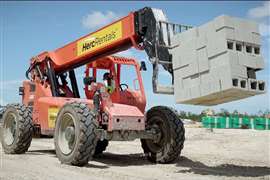Emissions regulations take step forward
05 May 2016
The next stage in the EU emissions regulations for construction machinery has taken a step forward with a compromise agreement approved by Member States’ representatives and the European Parliament’s Environment Committee.
The regulations are said to be the strictest in the world, but “reasonable” time limits to comply are being set out.
Final approval is expected to be given in a vote at the European Parliament in Strasbourg in July.
The Environment Committee almost unanimously approved the final agreement reached with the Council on the proposal for a regulation on requirements relating to emission limits and type-approval for internal combustion engines for non-road mobile machinery (NRMM). The plans had already been agreed with the Dutch Presidency of the Council.
European Parliament Rapporteur Elisabetta Gardini MEP said, “Today’s vote is the result of very hard work by the two co-legislators and is a significant step in the right direction. It is of the utmost importance since these engines contribute significantly to air pollution and are accountable for roughly 15% of NOx and 5% of PM (particulate matter) emissions in the EU.”
She said that negotiations had succeeded in “striking the right balance between the protection of the environment, the health of EU citizens and the competiveness of the EU industry”.
The new NRMM Regulation will cover all kinds of combustion engines installed in machines ranging from small hand-held equipment, construction machinery, generating sets, railcars and locomotives, and inland waterway vessels to harvesting and agricultural machinery.
The engines covered will meet the same requirements regardless of their fuels, a decision which is intended to boost innovation in the engine sector. A new in-service monitoring system has been set up to assess the engines’ performance in real life, which is designed to fill the gap between engine laboratory testing and real world emissions.
“We have tightened the limits proposed by the European Commission even further for many engines’ power ranges,” said Gardini. “But we kept the approach reasonable enough so that the industry can comply with the new requirements in a short time – and this was the most important goal.”
The agreement also allows some more time for SMEs (small- and medium-sized enterprises) to cope with the new requirements.
“This is in line with the ‘Think Small First’ principle, which has guided the EU institutional work for many years,” added Gardini.
“The new Regulation is very ambitious in terms of environmental protection. Europe will have the strictest emission limits in the world as from 2019.”
She said the other two regulated markets – Japan and the US – were lagging behind.
“However,” she said, “the Regulation provides for new transition clauses making it reasonable to introduce the new Stage V for those companies that will implement it in their businesses, especially small companies which are the backbone of our economy.”
There are also provisions for some replacement engines, which is an issue that has been a cause for concern for CECE (Committee for European Construction Equipment) among others.






